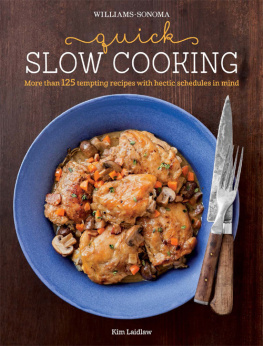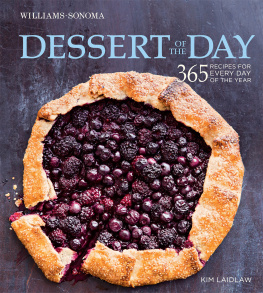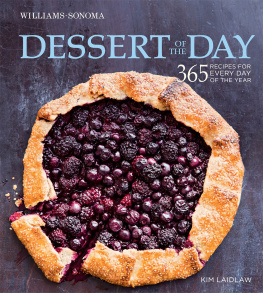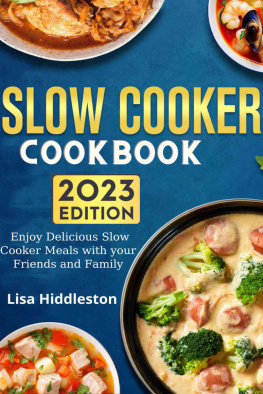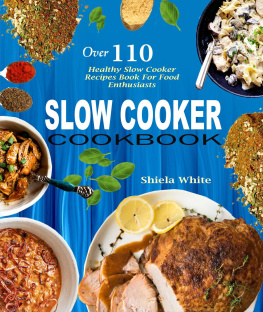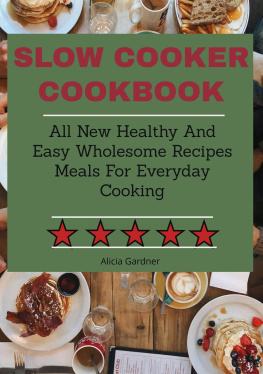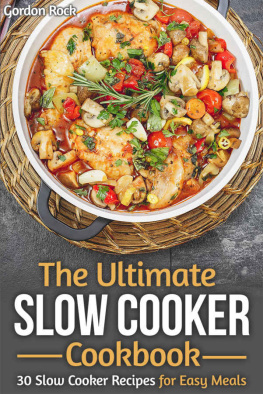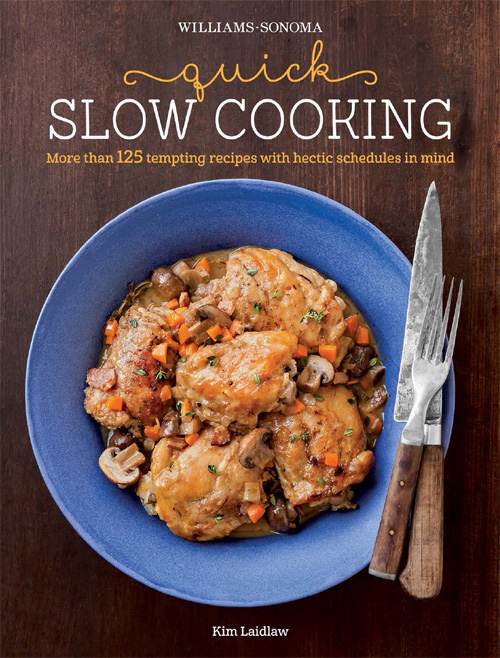


a new take on slow cooking
A slow-cooker book that claims to help you put together a meal quickly sounds like a contradiction. And yes, its true that start-to-finish times for dishes prepared in a slow cooker are usually pretty long. But the tool itself is a true time-saver for busy cooks. Once the ingredients are in the cooker, they typically require little or no attention until youre nearly ready to sit down and eat.
A slow cooker promises easy preparation and delicious results, a combination that is rarely possible with most cooking methods. When left to cook slowly in seasoned liquids, tough cuts of beef, pork, or lamb become meltingly tender. Chicken takes on deep flavor from the seasonings it simmers in, and fish and shellfish maintain their delicacy in the moist heat. Beans cook like they were meant to, holding their shape yet becoming velvety and full flavored, and the sturdiest vegetables soften in texture and intensify in flavor.
In this new take on slow cooking, youll find more than 120 recipes developed with the hectic schedule of a home cook in mind. The recipes boast streamlined ingredient lists, a minimum of steps, and are either a one-pot dish or a main course that can be turned into a meal with a purchased or easily assembled side dish. Some of the steps, such as marinating meat or cutting up vegetables, can be done the night before to save time on the day you cook. Browning, which is a great flavor-producing step, is optional whenever possible, so that harried cooks can choose just to assemble the dish, turn on the cooker, and go about their day. Tips and tricks for the busy cooksuch as how to choose the best slow cooker, how to plan meals ahead of time, and how to round out the menu of a slow-cooked dinnerwill not only save you precious time but also ensure that you can put a satisfying, home-cooked meal on the table.

dinner is just a few steps away
I developed these recipes with the busy cook in mind. Each one consists of six steps or fewer, but many have just two or three steps. Following is a key to the recipe steps and the part that each one plays in my philosophy of quick slow cooking.
PREP This step applies to tasks that are done before an ingredient hits the heat, such as seasoning meat with salt and pepper, dusting it with seasoned flour, or marinating it. It might also include stirring together a handful of ingredients for a sauce or other mixture. Sometimes the prep can be done the night before cooking, which saves you time the next day.
BUILD FLAVOR Browning helps build an extra layer of flavor in a recipe. In some recipes it is optional, but if you have a few extra minutes or if you plan to serve the dish to company, it is worth the time. In other recipes, browning is essential to the success of the dish. Be sure to follow the cues in the recipes.
QUICK COOK Sometimes, a brief initial cooking of aromatic ingredients or vegetables helps to kick-start the slow-cooking process. If you can do this step in the slow-cooker insert rather than in a frying pan, you wont have an extra pan to wash.
SLOW COOK This is the heart of the recipe, the point at which you add the main ingredient, cover the slow cooker, press start, and walk away until the dish is done or nearly done.
ASSEMBLE Some recipes call for one or two last-minute tasks, such as defatting and then simmering the braising liquid to reduce it, slicing a roast, or stirring together ingredients for an accompanying sauce.
SERVE This step offers tips for getting the dish from the cooker to the table in style. It typically includes ideas for serving vessels and an easy finishing touch, such as a sprinkle of chopped herbs, a squeeze of fresh citrus juice, or a drizzle of olive oil.
CHOOSING INGREDIENTS
In keeping with the quick-cooking theme, the recipes in this book have a relatively short list of fresh ingredients, so choose those ingredients with care. Im of the feeling that the better the quality of the ingredients that you choose, the better your end result. For fresh vegetables, particularly root vegetables, I find that choosing in-season and organic results in fuller flavor and better texture. When it comes to meat, poultry, and seafood, make every effort to choose from sustainable sourcesyou really can taste the difference, plus its a healthier option for the environment. Also, when selecting large cuts of meat such as pork shoulder or beef brisket, choose cuts that are well-marbled: you need the fat to keep the meat moist while braising. I prefer bone-in chicken thighs over breasts when using the slow-cooker; the meat stays moist and flavorful and wont dry out. Be sure to remove the skin unless you are browning the meat.

about slow cookers
The recipes in this book are designed for a 6- to 7-quart (6- to 7-liter) slow cooker with a removable cast-aluminum insert and dual temperature setting. These two features allow you to saut vegetables and other aromatics or brown meats and poultry on the stove top to build flavor and then return the insert to the cooker for long cooking on either the low-heat setting (about 170F/77C) or the high-heat setting (about 280F/138C). If you have a smaller slow cooker, you can easily halve many of the recipes (unless youre cooking a large roast) without changing the cooking time. I prefer to cook most recipes on the low-heat setting, which helps deliver fuller flavors and render tough cuts of meat meltingly tender.
When making any recipe, be sure to follow the directions for temperature setting and for timing, as they are the keys to safe and successful slow cooking. Some recipes offer both a low-heat option and a high-heat option to make it easier to fit them into your schedule. Todays slow cookers tend to cook at higher temperatures than the slow cookers manufactured in previous years. Bear this in mind if you are preparing the recipes in this book using an older modelyou may need to add to the overall cooking time, or select the high-heat setting and decrease the cooking time slightly. It is also important to read carefully through the instruction book that came with your slow cooker. It will detail the products features, information that will help you get the most out of the appliance.
The dual-temperature feature is a boon for the busy cook, making it easier to tailor slow cooking to any schedule: the high-heat setting completes cooking in roughly half the time of the low-heat setting. Recipes that specify low heat are typically ideal for when you want to turn on the cooker early in the day, before you leave the house, so that they are ready by dinnertime. High-heat recipes are especially practical for weekends, when you may want to start the cooker in the afternoon for dinnertime. Many models also have a warm setting that holds food at the ideal serving temperature, automatically switching to it when cooking is done.

